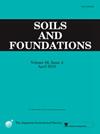The effect of salt on the freezing temperature of saline soil
IF 3.3
2区 工程技术
Q2 ENGINEERING, GEOLOGICAL
引用次数: 0
Abstract
The freezing temperature jumping phenomenon in saline soils caused the freezing temperature activity model to fail. In this study, the freezing temperatures and the rapid freezing water change Δwff of three typical saline soils (NaCl, Na2SO4, and Na2CO3 saline soils) were measured under different water and salt contents using temperature change curves during cooling. The effects and mechanisms of water content, salt content, and salt type on the freezing temperatures of saline soils were analyzed from three aspects: water activity of pore solutions, salt precipitation, and the rapid freezing water change Δwff. The results indicated that the mechanism by which water and salt content affected the freezing temperature of soil was through changes in the water activity of the pore solution. For salt solutions with solubility insensitive to temperature changes, the activity model adequately described the influence of water activity on the solution’s freezing temperature. For salt solutions with solubility highly sensitive to temperature changes, the activity model was applicable when the salt concentration was less than or equal to the jump characteristic concentration. When the salt concentration exceeded the jump characteristic concentration, the freezing temperature jump phenomenon occurred, rendering the activity model inapplicable. Solution salt precipitation caused the freezing temperature jump phenomenon. For saline soils with salt solubility significantly affected by temperature, salt precipitation should be considered when calculating freezing temperatures. The soil’s freezing temperature, as measured by the freezing temperature curve, was influenced by the rapid freezing water change Δwff. When the rapid freezing water change Δwff was greater than or equal to the critical change in frozen water content Δwcrf, the soil’s freezing temperature equaled the equilibrium temperature of the pore solution. When the rapid freezing water change Δwff was less than the critical change in frozen water content Δwcrf, the freezing temperature gradually decreased from the equilibrium temperature of the pore solution to the supercooling temperature as the rapid freezing water change Δwff decreased.
盐对盐渍土冻结温度的影响
盐渍土冻结温度跳变现象导致冻结温度活动模型失效。本研究利用冷却过程温度变化曲线,测定了3种典型盐渍土(NaCl、Na2SO4和Na2CO3盐渍土)在不同水盐含量下的冻结温度和快速冻结水变化Δwff。从孔隙溶液的水活度、盐沉淀和速冻水变化Δwff三个方面分析了含水量、含盐量和盐类型对盐渍土冻结温度的影响及其机理。结果表明,水盐含量影响土壤冻结温度的机制是通过改变孔隙溶液的水活度来实现的。对于溶解度对温度变化不敏感的盐溶液,活度模型充分描述了水活度对溶液冻结温度的影响。对于溶解度对温度变化高度敏感的盐溶液,当盐浓度小于或等于跳跃特征浓度时,活度模型适用。当盐浓度超过跳跃特征浓度时,发生冻结温度跳跃现象,使活度模型不适用。溶液盐沉淀引起冻结温度跳变现象。对于盐溶解度受温度影响较大的盐渍土,在计算冻结温度时应考虑盐降水。由冻结温度曲线测定的土壤冻结温度受冻结水快速变化Δwff的影响。当冻结水快速变化Δwff大于等于冻结水含量的临界变化Δwcrf时,土壤的冻结温度等于孔隙溶液的平衡温度。当速冻水变化Δwff小于速冻水含量的临界变化Δwcrf时,随着速冻水变化Δwff的减小,冻结温度从孔隙溶液的平衡温度逐渐降低到过冷温度。
本文章由计算机程序翻译,如有差异,请以英文原文为准。
求助全文
约1分钟内获得全文
求助全文
来源期刊

Soils and Foundations
工程技术-地球科学综合
CiteScore
6.40
自引率
8.10%
发文量
99
审稿时长
5 months
期刊介绍:
Soils and Foundations is one of the leading journals in the field of soil mechanics and geotechnical engineering. It is the official journal of the Japanese Geotechnical Society (JGS)., The journal publishes a variety of original research paper, technical reports, technical notes, as well as the state-of-the-art reports upon invitation by the Editor, in the fields of soil and rock mechanics, geotechnical engineering, and environmental geotechnics. Since the publication of Volume 1, No.1 issue in June 1960, Soils and Foundations will celebrate the 60th anniversary in the year of 2020.
Soils and Foundations welcomes theoretical as well as practical work associated with the aforementioned field(s). Case studies that describe the original and interdisciplinary work applicable to geotechnical engineering are particularly encouraged. Discussions to each of the published articles are also welcomed in order to provide an avenue in which opinions of peers may be fed back or exchanged. In providing latest expertise on a specific topic, one issue out of six per year on average was allocated to include selected papers from the International Symposia which were held in Japan as well as overseas.
 求助内容:
求助内容: 应助结果提醒方式:
应助结果提醒方式:


